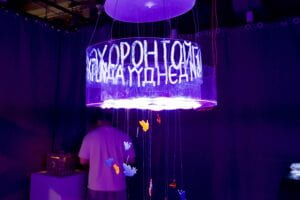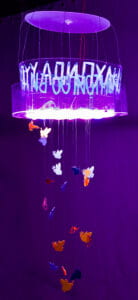Title
Eh Oron (Mother Land)
Project Description
This project, titled “Eh Oron (Mother Land)”, is a kinetic light sculpture that combines futuristic aesthetics with cultural symbolism. I was inspired by the idea of scrolling LED display and decided to create a piece that blends modern technology and some Mongolian elements. The central concept behind the work is to represent my connection to my homeland, Mongolia, through the use of circular motion, neon lighting, and a symbolic quote written in Mongolian.
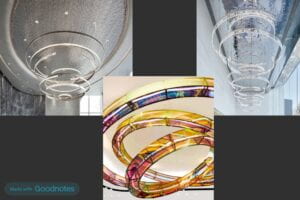
The project features a transparent circular box housing a scrolling transparent display with text that rotates around, driven by a stepper motor. The text displayed on the plastic sheet is a Mongolian phrase that translates to “I am too similar to my country”, which reflects my sentiment of being deeply intertwined with my motherland. The use of blue and pink neon tubes represents the colours of the Mongolian national flag, adding a vibrant and visual element to the piece.
Additionally, I have added hanging pigeons that also rotate around the central structure, alluding to the cultural significance of the pigeon as we call our country “The land of eternal blue sky” and when thinking of the sky, it reminded me of birds.
Perspective and Context
My approach to this project aligns with the ideas explored in the readings and the research I did on the perception and interpretation of light-based artworks. The project’s interplay of light, movement, and symbolic imagery invites the viewer to engage with the work on both a sensory and conceptual level, enabling a deeper understanding of my cultural and personal connections.
Furthermore, the project’s kinetic nature, the continuously rotating display and the balance of the hanging pigeons create a sense of ongoing transformation, encouraging the people to interact with the work dynamically.
Development & Technical Implementation
The development of this project involved a multiple process that combined design, sculpting, and artistic expression. I began by sketching the initial concept and considering the materials and components needed to bring the idea to life.
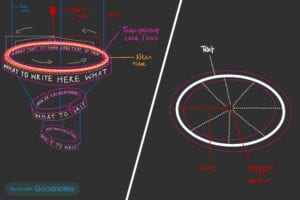
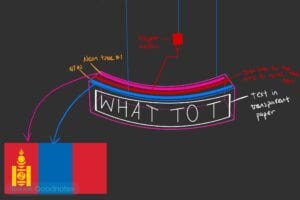
The main technical challenges centred around the construction of the transparent circular enclosure and the integration of the rotating display, neon tubes, and hanging pigeons. I experimented with various materials, including laser-cut acrylic rings and plastic sheets, to create the structure and housing for the different elements.
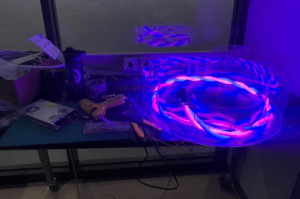
The integration of the stepper motor, wiring, and power supply was another crucial aspect of the technical implementation. I had to carefully test and troubleshoot the electrical components to ensure the smooth and synchronised rotation of the text display and the hanging pigeons.
The final result is a carefully balanced kinetic sculpture. The audience is encouraged to observe the work from different angles, as the interplay of light, motion, and symbolic imagery creates a unique experience.
The process of building:
Presentation
The presentation of this project during the class and the IMA show was a valuable experience for me. While the initial in-class presentation had some technical problems, I was able to fix my project before the IMA show.
During the IMA show, I received positive feedback from the audience, particularly from my Mongolian peers who were able to understand the meaning of the text and appreciate the cultural references. People were interested in the struggle and subsequent recovery of the rotating mechanism, which was a problem I had to fix. However, some people interpreted it as a metaphor for the challenges and resilience of life.
The kinetic nature of the piece also captured the attention of the viewers, especially the kids who were fascinated by the moving pigeons. This interaction and engagement with the audience demonstrated the project’s ability to create a sense of curiosity, inviting the viewers to explore the work on a deeper level.
While the presentation went well overall, I acknowledged that there was room for improvement, particularly in ensuring the reliability and consistency of the rotating mechanism. This experience has provided valuable insights for me to consider in future projects, where I can refine the technical aspects while maintaining the conceptual depth and emotional resonance of the work.
Conclusion
The creation of this project has been a fun journey for me, marked by both challenges and discoveries. One of the key lessons I learned was the importance of embracing unexpected issues and finding creative ways to enhance the work, even when the initial results differ from the original idea.
Through the process of designing, building, and troubleshooting the various components, I gained a deeper understanding of the technical and logistical aspects of kinetic art. This knowledge, I hope, will undoubtedly inform my future projects, where I can apply these lessons to develop more reliable techniques while maintaining the conceptual part of the work.
Looking ahead, this project has motivated my desire to create works that resonate with my personal and cultural identity, while also engaging the audience in a visually and conceptually compelling manner. 